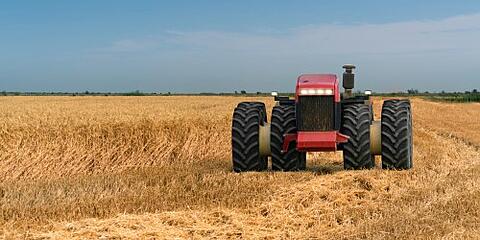Welcome to Agritech 5.0; your future may depend on it

By Neil Sharp, JJS Manufacturing

Neil Sharp
The effects of climate change and a century of environmental destruction are threatening to halt millennia of human progress. Can Agritech 5.0 save us from ourselves?
At every stage of human history, farming technology has evolved to support us in our most critical survival goals. We have used it to build stronger societies, underpinned by better nutrition, food security and life expectancy. Now the fifth agricultural revolution (Agritech 5.0) is poised to solve our latest, existential crisis. Will it succeed?
Welcome to the dust bowl
Global warming, exhausted soil, labour shortages and successive droughts have all caused a perfect storm in the farming industry. It’s becoming more costly and difficult to farm land around the world, but the world needs more food than ever before:
“According to the UN Food and Agriculture Organization (FAO) 800 million people are suffering from hunger & approximately 8% (650 million) of the world population will be undernourished in 2030. While agriculture’s share of global GDP has just shrunk to 3% we will need to produce 70% more food by 2050.”
Intensive farming and the mass application of chemicals were once thought to be the answer to extracting maximum value from the land and ‘feeding the world’. But the trend for factory farming that reached its heights in the 70s and 80s has finally given way to more considered, long term thinking.
Designing a new product? You might want to read this
The latest revolution: Agritech 5.0
Agritech is no longer focused on eking out the last ounce of productivity from existing farmland through the indiscriminate use of industrial fertiliser, herbicides and ‘prairie farming’ techniques.
Instead, autonomous machinery powered by AI and sensor tech are now working the soil and managing agricultural tasks in much more sustainable ways.
Sensors and robotics are reducing the need for chemicals, replicating the intelligence and delicacy of the human touch; while increasing productivity and yield. Now crops can be cared for in a targeted way while the land’s moisture levels and PH balance can be monitored and controlled in real time.
How robotic weeding is lowering costs and saving the planet
In Hampshire, in the UK, Tom and Dick (two robots developed by the Small Robot Company) are patrolling the fields of the Lockerlery Estate. Tom rolls across acres of land scanning the crops, plant by plant, building a digital map of problem soil weeds and other threats. Meanwhile, Dick follows to “electrocute every single weed detected with a small puff of smoke, and zero chemicals.” The machinery is lightweight and electric powered to cut down on compacted soil and greenhouse emissions.
Since the arrival of the robots, the farm has reduced its use of pesticides by 41% and fertiliser by 32%. New life has also been bought to the land through a mixture of high tech plant, crop rotation, agronomy and (in a traditional touch) a 1,000-strong herd of grazing sheep.
How did we get here? A short history of farming from stone tools to sensor tech
Agritech 1.0
In the beginning humans were hunter gatherers. Then, 6000 years ago, farmers started to cultivate wheat and domesticate animals. With iron plough shares they found they could bring more land under cultivation. For the first time, farming technology made large scale, organised food production and storage possible. It enabled the growth of villages, towns and cities.
Agritech 2.0
Farming technology went practically unchanged for millennia. Oxen pulled ploughs; people harvested by hand. But in the 18th and 19th Centuries, new tools and techniques suddenly transformed the speed and efficiency with which we farmed.Crop rotation, steam power, steel work, seed drilling and threshing technology made ploughing, planting and harvesting more effective and productive.
Agritech 3.0
Between the 1950s and the 1970s, industrial chemistry and novel opportunities for mechanisation bought a new wave of efficiency and productivity to farming. Fertiliser, herbicides and pesticides, crop spraying, tractors, combine harvester and veterinary drugs, all helped turned farms into factory farms. They produced more food more cheaply and made more profits for landowners.
Agritech 4.0
As the internet age dawned, new technology began to refine the potential for mechanisation. Satellite controlled combine harvesters and drone surveys made the most of every meter of land under cultivation. Giant piggeries, and mega-dairies sprung up, with buildings controlled by data, remote technology and robotics. Animal health was optimised through drugs. Yield could be more precisely calculated and performance improved ‘through the flick of a switch.’
Agritech 5.0
Now, a new generation of Agritech has begun. Just as industry 5 .0 looked to bring a new era of social responsibility to manufacturing, Agritech 5.0 is looking to bring higher yield, but more sustainable farming techniques within reach of every farmer. Robotics, cloud computing, specialized software, and the Internet of Things are all being integrated into machinery to farm using less labour, energy, chemicals and destructive machinery. And, thanks to indoor and vertical farming techniques, to produce food without access to conventional farmland at all.
Can we make Agritech accessible to all?
Agritech is a huge opportunity. In 2019, the value of Agritech to the global economy was $17,442.7 million by 2027 it is projected to reach $41,172.5 million.
Innovation in the sector is promising to feed the world while protecting its delicate ecosystems; bringing growth, prosperity and food equality for all.
As part of this mission, robotics are helping agricultural operations of all kinds with high yield, low impact, precision farming solutions.
Smart farming for everyone?
Machinery is becoming more adept at pollinating and growing plants in the most unlikely ways and places. Advances in MEMS sensors, AI tech and robotics mean that even the most delicate crops can now be planted, tended and harvested automatically.
Vertical farms are springing up in urban centres, with spaces between skyscrapers given over to food cultivation co-run by robots and humans. Food production is being optimised for power and water consumption to minimise environmental damage.
Through strides in Agritech like this, greater varieties of food will become cheaper and more accessible to millions of people, improving year-round nutrition and quality of life for all.
Cost and availability of Agritech must be addressed
The cost of sustainable Agritech must continue to fall to address the acute demands of a world in ecological peril, where food inequality and insecurity is rife. The need is there, the market is there; now the innovation must be value-engineered to increase its influence and reach.
As James McCew Regional Director for Asia-Pacific in Universal Robots points out in this article more traditional farming communities have been sceptical about these developments:
“Farmers can believe that robots in agriculture are expensive to purchase, inflexible, space-hogging, and require engineers to program them”
But if the whole world is going to benefit from Agritech, these beliefs have got to be challenged.
Who can value engineer Agritech?
Agritech developers need to bring their products to a wide range of international customers. Their solutions need to be adapted for different terrains and ecosystems, where different resources are available and challenges are present.
This might mean redesign and optimisation, through the use of different components, materials and power sources. Agribots and smart tools will need to be made more durable, responsive and agile. Industrial sized solutions may need to be scaled down (or reimagined completely) to become relevant for different markets.
In the midst of the latest Agricultural Revolution innovators are going to need the right partners to help them value engineer their products to maximise their potential. They will need manufacturing specialists to help them bring their brilliant ideas to all the farmers who will feed us in the future.










